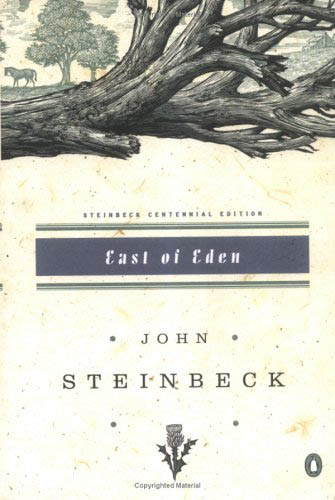 My favorite pre-Asian American studies, pre-Asian American power, pre-civil rights fictional Asian American character is Lee from East of Eden (1952) by John Steinbeck.
My favorite pre-Asian American studies, pre-Asian American power, pre-civil rights fictional Asian American character is Lee from East of Eden (1952) by John Steinbeck.
East of Eden is a long epic novel. So it’s difficult to try to encapsulate the entire story in a few short sentences. The best I could find was from the Oprah Book Club: “Three generations, two love triangles, one timeless story. East of Eden is an epic novel full of good and evil, love and hatred, failure and redemption.” (Click here to read a full synopsis of the book.)
Lee is the main character’s Chinese American servant. The first time I read the book I cringed when I saw that he spoke in an offensive pidgin English dialect. I admit I was disappointed that my writer hero would resort to such easy caricatures. However, the truth turned out to be much much more complicated than that. In many ways, Steinbeck manages (through Lee) to explain the duality of being both Asian and American (even today) and how non-Asians relate or see us.
Here’s an excerpt from the book that shows what I’m talking about:
(Page 160)
“Lee,” he said at last, “I mean no disrespect, but I’ve never been able to figure out why you people still talk pidgin when an illiterate baboon from the black bogs of Ireland, with a head full of Gaelic and a tongue like a potato, learns to talk a poor grade of English in ten years.”
Lee grinned. “Me talkee Chinese talk,” he said.
“Well, I guess you have your response. And it’s not my affair. I hope you’ll forgive me if I don’t believe it, lee.”
Lee Looked at him and the brown eyes under their rounded upper lids seemed to deepen until they weren’t foreign any more, but man’s eyes, warm and understanding. Lee chuckled. “It’s more than a convenience,” he said. “It’s even more than self-protection. Mostly we have to use it to be understood at all.”
Samuel showed no sign of having observed any change. “I can understand the first two, he said thoughtfully, “but the third escapes me.”
Lee said. “I know it’s hard to believe, but it has happened so often to me and to my friends that we take it for granted. If I should go up to a lady or gentleman, for instance, and speak as I am doing now, I wouldn’t be understood.”
“Why not?”
“Pidgin they expect, and pidgin they’ll listen to. But English from me they don’t listen to, and so they don’t understand it.”
“Can that be possible? How do I understand you?”
“That’s why I’m talking to you. You are one of the rare people who can separate your observation from your preconception.
(And from Page 161)
“I’m wondering whether I can explain,” said Lee. “Where there is no likeness of experience it’s very difficult. I understand you were not born in America.”
“No, in Ireland.”
“And in a few years you can almost disappear; while I, who was born in Grass Valley, went to school and several years to the University of California, have no chance of mixing.”
“If you cut your queue, dressed and talked like other people?
“No. I tried it. To the so-called whites I was still a Chinese, but an untrustworthy one; and at the same time my Chinese friends steered cleared of me. I had to give it up.”
I often feel like Lee. Let me give you one example. Because I work in Little Tokyo (in downtown Los Angeles) I’m often asked for directions. When I’m in a hurry (or just not feeling very friendly/helpful) I tell people that I don’t speak English. I know Asian people who use “Asian” accents when they do that but what I found is that I don’t need one. The people asking accept it as fact right away (this despite the fact that I am speaking perfect English). As Lee said, “But English from me they don’t listen to, and so they don’t understand it.”
Lee is not a perfect character. In many ways (as the story progresses) he becomes more stereotypical, but we should keep in mind that it was the 1950s and Steinbeck’s views were considerably more understanding and nuanced than the majority of people in America.
While doing research for this article, I found this wonderful dissertation about Lee that will give much more in-depth analysis on him. Also, if you’re interested in reading the book itself, you can read it on Google books. Better yet, support your local bookstore and buy yourself a copy.
Tell me your favorite pre-1960’s fictional Asian American character and why.
- Excited
- Fascinated
- Amused
- Disgusted
- Sad
- Angry








